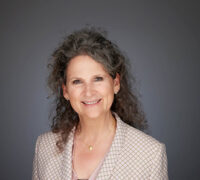
Stress busters: how to help employees help themselves
Dr. Rachel Lewis explores how empowering teams to co-create solutions can reduce workplace stress and boost wellbeing...

by Susan Goldsworthy Published June 25, 2024 in Leadership • 9 min read
Are executives in crisis? A growing body of evidence suggests that many are.
The litany of stressful global events under way at present can affect anyone. Indeed, there is strong evidence of a global rise in workplace unhappiness. Gallup’s State of the Global Workplace: 2023 report found that a decade of elevated stress levels had culminated in record levels of anxiety among workers. Among leaders, these symptoms are particularly pronounced. They must carry responsibility for navigating through these challenges while operating in a crucible where external pressures combine (and sometimes conflict) with the expectations of shareholders and boards.
The reality is that the global challenges we face are not going away any time soon. We must learn how to lead through them. But the answer cannot be simply “work harder.” The question is: How can leaders perform to the standards required of them while staying grounded and healthy?
Fortunately, research points to practical, effective steps that leaders can take to reduce stress and boost energy levels, and indicates what CHROs can do in collaboration with other senior leaders to initiate and role-model change.
My research uses the model for energy zones developed by Tony Schwartz. It is a classic 2×2 grid. The level of energy – high or low – is on the Y-axis, with the quality of energy – positive or negative – on the X-axis. High and positive energy is the performance zone; low and positive energy is the crucial recovery zone. The high and negative quadrant is survival, while low and negative energy is the burnout zone.
Since April 2020, I have gathered input from more than 6,000 leaders. The most striking finding is that between one- and two-thirds are operating on a day-to-day basis in the survival zone. The results show that leaders are finding it hard to reach the performance zone and, in discussion, leaders say that, when they do reach it, they cannot stay there, soon slipping back into survival and edging towards burnout.
Putting aside global crises for a moment, CHROs should recognize that the shift to remote and hybrid working has in itself contributed to rising stress levels. Spending less time in the company of our colleagues, it is easy to become disconnected and to begin to feel isolated.
Video conferencing promises to bridge those gaps but it also creates its own problems. Research by Microsoft’s Human Factor Labs has highlighted the stress created by back-to-back virtual meetings over a protracted period. When this stress impacts leaders, the quality of their decision making and communication suffers, damaging professional interpersonal relationships.
“You still want a break – so you stay up late, binge-watching the latest hit series, instead of going to bed at a sensible time.”
There is another compounding factor. Unfortunately, when we are under strain, we often neglect the activities that do the most to reduce stress. We stop spending time in the “recovery zone,” which is essential for rebuilding, and fall back on maladaptive coping responses.
Perhaps you recognize the pattern. You feel tired, so you cut down on exercise. You have a presentation to finish, so you cancel the planned catch-up with a friend or dinner with a partner. You still want a break – so you stay up late, binge-watching the latest hit series, instead of going to bed at a sensible time. You might increase your caffeine and alcohol intake, too.
Some of these factors can only be addressed by taking greater personal responsibility to achieve a healthy balance. But organizations have an important role to play in offering them the support to do so.
Businesses also have a strong vested interest in helping executives (indeed, staff at all levels) to reach the “performance zone.” Quite simply, organizations need their people to be at their best if their businesses are to succeed in a highly competitive world.
Yet too many are still held back by outdated, macho mindsets. For example, the attitude that praises leaders for exhibiting unhealthy levels of stamina and rewards 24/7 responsiveness. This is deeply unhelpful. When we’re exhausted, our decision-making capabilities drop dramatically, and we become prone to errors. Organizations need to change the culture to one that says, “We want people here for what they bring, not the hours that they spend.”

“What can we do to make this a space where people can thrive?”
CHROs must ask themselves and other leaders the question, “What can we do to make this a space where people can thrive?” Along with the CEO and the top team, the CHRO should then spearhead the resulting agenda.
Obviously, CHROs cannot simply mandate behavioral shifts based on the latest neuroscience research. They need to consult and engage top leadership and secure their support for the changes needed to help people thrive.
Critically, CHROs need senior leaders to role-model the shift. Top leadership might present changes as important but, unless they can demonstrate in their own work the principles upon which those changes are based, executives below them in the organization will not take their words seriously.
Below, we offer five areas where CHROs can work with senior leaders to role-model change and help executives recharge their batteries.
1. Create spaces where people can talk about feelings. The best way to create an inclusive, psychologically safe culture is to build an environment where people can share their feelings freely. For example, “I’m exhausted today. I’m wiped.” And colleagues can respond positively: “I hear you. Thanks for sharing.”
The point is not to “fix” every situation as soon as it arises. What’s important is that people can share their emotional state. When people feel heard, it reduces feelings of upset, creates a sense of safety and promotes calmness, enabling the individual to focus better on work, knowing that their colleagues and managers have their back.
This type of conversation may need to happen frequently, especially in remote teams where people have to connect via screens.
2. Write down the things you can’t change – and the things you can. The next step is a good exercise to use with leadership teams. Write down on sticky notes anything that is bothering you that you can do nothing about. This could range from huge concepts such as geopolitical tensions or international war – or stresses in your own life relating to family or relationship issues, for example. Everyone participates.
Problems are put on the wall, where everyone can see and digest them, with the opportunity to acknowledge their impact on us. Much like voicing our feelings, this act of recognition has benefits for individuals and, done collectively, it can strengthen team dynamics by promoting empathy and mutual understanding.
The next step is equally important, however: write down things where action can be taken. This introduces a sense of agency, structure and relief, allowing people to return to thinking about their work with a more positive sense of focus.
3. Be smart about scheduling. The Microsoft research on the stress that accumulates as a result of back-to-back meetings also identifies a simple solution: take short breaks between them. Even 10 minutes away from the professional environment allows us to decompress and reset before our next engagement. Role-modelling is key. There is little point in the CHRO recommending 10-minute breaks if everyone sees the CEO continuing to conduct back-to-back calls.

4. Breathe together. Neuroscience research shows that we can alleviate stress by activating the parasympathetic nervous system – the network of nerves that relaxes the body after periods of stress – through controlled breathing. Our breath can be our medicine.
A good option for relaxation is the 4, 7, 8 technique: inhale deeply through the nose for a count of four, hold for seven, and exhale through nose or mouth for eight. (This can also be used to relax before sleeping.) Another technique is box breathing, as used by Navy Seals: breathe in deeply through the nose for four, hold for four, breathe out for four, and hold for four. This encourages relaxation and focus. Some organizations now even start meetings with a couple of minutes of breathing exercises, helping people to get into a good headspace before discussion begins.
5. Ask people to leave their phones at the door. Our 24/7 digital connection vastly increases our vulnerability to stress and the risk that we opt for maladaptive coping mechanisms. For example, we might spend a break period scrolling LinkedIn or Instagram, rather than pursuing genuine forms of relaxation away from our screens. Our screen addiction can also form a barrier between us and our colleagues when we’re on-site and have the precious opportunity to build and renew personal connections. Several organizations are now addressing this problem by asking people to check their phones at the office door.
Leaders should also consider leaving their phones outside the door at home – specifically, the bedroom door. Our phones distract and disturb us at night. Allowing ourselves some freedom from contact with the outside world is important.
“When a plant’s leaves are pulled off, we cannot simply stick on new ones. We all need rest and recovery time.”
Ultimately, escaping from the trap of low- and negative-energy zones requires a change of mindset. We are all living systems. The language of business is dominated by machine-oriented and warlike terms: the engine of growth, big battles, deadlines, and bullet points. If a machine breaks, we can fix it. But human problems are usually more complicated. If a living system breaks, recovery can be slow and challenging. When a plant’s leaves are pulled off, we cannot simply stick on new ones. We all need rest and recovery time.
CHROs are central to this effort. They must support leaders in learning how to cope, so the latter can deliver the energetic standards of performance that the extraordinarily challenging business environment of today demands.

Affiliate Professor of Leadership, Communications and Organizational Change at IMD
Susan Goldsworthy OLY is an Affiliate Professor of Leadership, Communications and Organizational Change at IMD. Co-author of three award-winning books, she is also an Olympic swimmer. She is a highly qualified executive coach and is trained in numerous psychometric assessments. She is Director of the IMD Executive Coaching Certificate and Program Director of the Leading Sustainable Change program.

June 23, 2025 • by Rachel Lewis in Human Resources
Dr. Rachel Lewis explores how empowering teams to co-create solutions can reduce workplace stress and boost wellbeing...

May 13, 2025 • by Luca Condosta in Human Resources
The CDO, formerly a figurehead for regulatory compliance, is now a key driver of company strategy. Luca Condosta describes the essential skills that CDOs require to turn DE&I concepts into actual commercial...

April 30, 2025 • by Manju Ahuja in Human Resources
The pandemic sparked a shift to remote work that’s proving hard to reverse. According to Prof. Manju Ahuja, hybrid models are the new norm—driven by employee expectations, technological advances, and a changing...

April 29, 2025 • by Michael D. Watkins in Human Resources
Use this diagnostic tool and roadmap to rebuild trust and confidence within dysfunctional teams – the first crucial steps toward a future of high performance....
 Audio available
Audio availableExplore first person business intelligence from top minds curated for a global executive audience